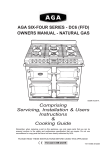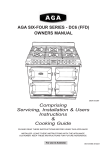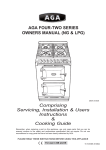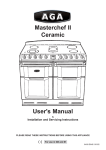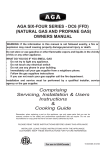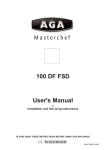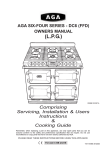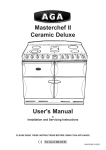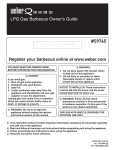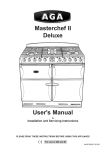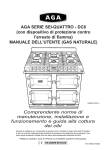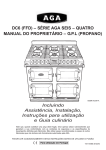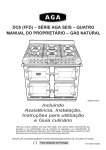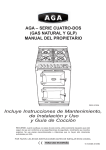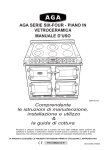Download AGA Six-Four Series Technical data
Transcript
AGA SIX-FOUR SERIES - CERAMIC HOB OWNERS MANUAL DESN 513131 Comprising Servicing, Installation & Users Instructions & Cooking Guide Remember, when replacing a part on this appliance, use only spare parts that you can be assured conform to the safety and performance specification that we require. Do not use reconditioned or copy parts that have not been clearly authorised by Aga. PLEASE READ THESE INSTRUCTIONS BEFORE USING THIS APPLIANCE For use in GB and IE 11/09 EINS 513129 CONTENTS SECTION PAGE INTRODUCTION PRODUCT VIEW 3 4 INSTALLATION SECTION 5 INSTALLATION TECHNICAL DATA FITTING AND PRODUCT DIMENSIONS ELECTRICAL CONNECTION LEVELLING AND MOBILITY WHEELS SPLASHBACK USERS GUIDE 6 7 8 9 - 10 11 12 13 HEALTH AND SAFETY CONTROL PANEL SETTING UP THE COOKER FOR USE CERAMIC HOB THE GRILL THE OVENS (GENERAL) SIMMERING OVEN SIMMERING OVEN RECIPES OVEN COOKING GUIDE THE MINUTE TIMER AUTOMATIC COOKING CONTROL CLEANING AND CARING FOR YOUR COOKER SERVICING SECTION 14 15 16 17 18 19 21 22 26 31 32 34 - 20 - 25 - 29 - 33 - 36 36 SERVICING WIRING DIAGRAM 37 - 41 42 2 INTRODUCTION As responsible manufacturers we take care to make sure that our products are designed and constructed to meet the required safety standards when properly installed and used. IMPORTANT NOTICE: PLEASE READ THE ACCOMPANYING WARRANTY. Any alteration that is not approved by Aga could invalidate the approval of the appliance, operation of the warranty and could affect your statutory rights. In the interests of safety and effective use, please read the following before using your new Aga appliance. Installation must be to local and national wiring regulations and carried out by a qualified engineer. A little smoke and some odour may be emitted when first switched on. This is normal and harmless (from oven lagging and starch binder on the element insulation) and will cease after a short period of use. Your appliance has a ceramic hob, three electric ovens; the lower right hand oven is a slow cooking oven, the upper right hand oven is a conventional oven. The lower left hand oven is an electric fan oven. The fan behind the rear panel ensures a virtually even distribution of heat within the oven during cooking i.e the temperature at the lowest shelf position is the same as the temperature at the highest shelf position. The electric grill is situated in the roof of the top left hand compartment. Refer to the diagram (See Fig. 1) to familiarise yourself with the cooker and refer to the relevant section for the simmering oven, fan oven, conventional oven and ceramic hotplate etc. Your cooker is supplied with the following accessories: 5 1 1 1 1 1 oven shelves large roasting tin grill shelf grill pan grill grid baking tray The following loose parts are also packed: ceramic hob and frame assembly electric chassis and fixing screws 1 splashback assembly 3 Fig. 1 DESN 513132 4 Installation Section Remember, when replacing a part on this appliance, use only spare parts that you can be assured conform to the safety and performance specification that we require. Do not use reconditioned or copy parts that have not been clearly authorised by AGA. 5 INSTALLATION WARNING: THIS APPLIANCE MUST BE EARTHED This appliance is designed for the voltage stated on the data plate, which is situated in the right hand vent slot at the base of the appliance. The Aga Six-Four Series Ceramic Hob is supplied from the manufacturers as a fully tested chassis construction. Ceramic hob, doors, splashback and handrail are assembled during installation. 6 TECHNICAL DATA HOTPLATE FRONT LEFT - double circuit - 2.2 kW/0.75 kW - 205/120mm dia - rapid heat up REAR LEFT - single circuit - 1.2 kW - 140mm dia - rapid heat up FRONT CENTRE - single circuit - 1.2 kW - 140 mm dia - rapid heat up REAR CENTRE - double circuit - 2.2 kW/0.75 kW - 205/220mm dia - rapid heat up FRONT RIGHT - single circuit - 1.5 kW - 155mm dia - rapid heat up REAR RIGHT - single circuit - 1.5 kW - 155mm dia - rapid heat up ELECTRIC GRILL AND OVENS TOP OVEN - POWER RATING - 2.0 kW GRILL ELEMENT - POWER RATING - 2.2 kW SLOW COOKING OVEN - POWER RATING - 0.9 kW LOWER OVEN (FAN) - POWER RATING - 2.0 kW POWER SUPPLY - 230V 50 Hz TOTAL LOAD 16.9 kW TOTAL WEIGHT OF APPLIANCE - 230 kg 7 FITTING AND PRODUCT DIMENSIONS Any adjacent walls that project above the height of the hob must be of heat resistant material. Any side wall above the cooker on either side shall not be less than 60mm horizontally from the cooker. (See Fig. 2). A minimum clearance of 1000mm must be available at the front of the cooker to enable it to be serviced. Surfaces over the top of the cooker must not be closer than 650mm. (Cooker Hood, see below). The vent slots in the back of the top plate must not be obstructed. The cooker must stand on a firm and level surface and we recommend that any soft material such as linoleum is removed. PLEASE NOTE WHEN FITTING A COOKER HOOD If a cooker hood is to be fitted, we only recommend the Six-Four Series CH900 cooker hood. It must be installed at a height of at least 800mm above the hotplate. DESN 513133 Fig. 2 8 ELECTRICAL CONNECTION ELECTRICAL CONNECTION IS LOCATED AT THE TOP RIGHT HAND SIDE OF THE APPLIANCE, BEHIND SIDE PANEL. DURING INSTALLATION REMOVE THE RIGHT HAND SIDE PANEL TO CONNECT ELECTRICAL SUPPLY. Remove 3 screws securing side panel to gain access to mains terminal. See Fig. 4 for location of cover. Remember that the mains electrical cable must be routed through the grommet at the rear right hand side of the cooker near the top, before connecting to the mains terminal connection. REFER TO FIG. 3 for wiring connection to appliance. Remember that an excess of cable length is required behind the cooker for the withdrawal of the cooker from between the kitchen units etc. SINGLE PHASE CONNECTION - The cooker requires a 45 amp power supply fitted in conjunction with a double pole isolator with a minimum contact clearance of 3mm and be connected to the mains with a minimum 10mm2 cable to comply with the latest editions of the local and national wiring regulations. THE ISOLATOR MUST NOT BE POSITIONED IMMEDIATELY ABOVE THE COOKER, BUT MUST BE SITED WITHIN 2 METRES OF THE APPLIANCE. Replace the right hand side panel once electrical connection has been made and replace fixing screws. NOTE: Ensure that the insulation card covering the mains terminal is in place, between the side panel and mains terminal. SINGLE PHASE CONNECTION - Minimum 10mm2 cable and must comply with the latest editions of the Local and National Wiring Regulations Fig. 3 DESN 513135 9 ELECTRICAL CONNECTION (CONTINUED) 2 THREE PHASE CONNECTION - Minimum 2.5mm cable and must comply with the latest editions of the Local and National Wiring Regulations Fig. 3A L1 - 5.0 kW L2 - 4.65 kW L3 - 7.3 kW Fig. 4 DESN 513134 DESN 513136 10 LEVELLING AND MOBILITY WHEELS INSTALLATION/LEVELLING The Aga Six-Four Series Ceramic Hob is designed to stand on a flat and level surface, any unevenness may be overcome by adjusting the four levelling feet, one at each corner of the base plate. The adjusting screws are accessed by removing the hotplate casting (See section ‘To Remove Ceramic Hob and Frame’ - Servicing Section - Page 39). To raise the cooker turn screw clockwise, to lower turn screw anti-clockwise. Fig. 5 DESN 513148 There are rollers on the base of the cooker to allow for positioning. When the cooker is in the correct position, the four levelling feet can be adjusted to level the cooker. The feet must be lowered enough to prevent the cooker rolling out of position (See Fig. 5). 11 SPLASHBACK 1. Locate tabs on rear of splashback assembly, into the brackets on the upper rear of the cooker. (See Fig. 6). Push fully into place. Fig. 6 DESN 513137 12 Users Guide 13 HEALTH & SAFETY APPLIANCE YOUNG CHILDREN SHOULD BE KEPT AWAY FROM THE APPLIANCE AS SOME SURFACES CAN BECOME HOT TO TOUCH. z During use the appliance can become hot. Care should be taken to avoid touching heating elements inside the ovens and grill. Deep Fat Frying z Use a deep pan, large enough to completely cover the appropriate heating area. z Always dry food thoroughly before frying and lower it slowly into the hot oil or fat. Frozen foods in particular, will cause frothing and spitting, if added to quickly. z Do not try to fry too much food at a time, especially frozen food. This only lowers the temperature of the oil or fat too much, resulting in greasy food. z Keep the outside of the pan, clean and free from streaks of oil or fat. z Never fill the pan more than one-third full of fat or oil. z Never leave the fat or oil unattended during the heating or cooking period. z Never use a lid on the pan. z IMPORTANT: Oil is a fire risk, do not leave pans containing oil unattended. z In the event of fire cover with a lid and turn OFF the appliance. Do not attempt to extinguish the fire using water. Smother the flames on the hob, rather than attempting to remove the pan to the outside. Burns and injuries are caused almost invariably by picking up the burning pan to carry outside. 14 CONTROL PANEL Fig. 7 z DESN 515708 A The GRILL ELEMENT KNOB needs to be pushed in before turning in either direction. Clockwise Anti-clockwise both elements on middle element only z The HOB ELEMENT controls are operated also by pushing in the knob before turning to the required setting. z The OVEN CONTROL KNOBS which do not need to be pushed in, can only be rotated clockwise from the OFF position. z The HOB NEON illuminates when the hob is hot and therefore too hot to touch. There is a short delay after initial switch on. The neon remains on when the element is switched off until the temperature reduces to a safe level (although the hob may still be warm enough to cause minor discomfort). z The OVEN NEONS illuminate when ovens are switched on. When the required temperature is reached the neon will extinguish. 15 SETTING UP THE COOKER FOR USE Before you can use the lower left hand oven (the fan oven) of the appliance it will be necessary to set the ‘time of day’ clock (see page 31). This is a 24 hour clock, and when the power supply is initially switched on, or after an interruption in supply, the clock will show AUTO and 0.00 alternately. Fig. 8 SETTING THE TIME OF DAY 1. Press and hold the MINUTE TIMER and COOK TIME buttons at the same time, (the word AUTO flashes and the 0.00 is displayed steadily) press the + or minus - buttons until the required time of day is displayed. The time will increase/decrease from 12.00 hours in minute intervals, slowly and then gaining speed. The cooker is now ready for manual use. 16 CERAMIC HOB z DO NOT USE THE HOB IF IT IS CRACKED. z DO NOT PLACE ALUMINIUM FOIL ON THE HOB SURFACE. z The hob has the six following plates:front left - double circuit - 2.2 kW/0.75 kW - 205/120mm dia - rapid heat up rear left - single circuit - 1.2 kW - 140mm dia - rapid heat up front centre - single circuit - 1.2 kW - 140mm dia - rapid heat up rear centre - double circuit - 2.2 kW/0.75 kW - 205/120mm dia - rapid heat up front right - single circuit - 1.5 kW - 155mm dia - rapid heat up rear right - single circuit - 1.5 kW - 155mm dia - rapid heat up z When the hot plates are switched on, the heating area will glow red. z The hot plates contain a safety switch which limits the ceramic temperature if the plates are operated without a pan in position, or if the plates have been at maximum setting for longer than normal. To get the best out of your hob z Ensure that the pan covers the heating area. z Switch off the plates when the cooking is complete. z Do not cook directly on the hob surface. Always use a pan. z Do not use the hob as a chopping board or resting area. z Always lift the pan off the surface. Do not drag or slide the pans into position. z Always use the recommended cleaning materials and methods. See ‘Cleaning and Caring’ section. Choice of saucepans z Only smooth flat based pans recommended for use on ceramic hobs must be used. z If cast iron pans are used, ensure they have a machined flat base. z Never use recessed or ridged base pans. z The base of the pan should cover the heating area. z Select a pan of sufficient size to avoid spillage (boiling over). Especially when cooking food containing sugar e.g. jam, marmalade, fruit etc. z Do not overlap the edge of the ceramic hob area with pans, as this will result in damage to the enamelled surface of the top plate. z For best results the bottom of the enamelled pan should be 2 - 3mm thick, stainless steel should have sandwich bottoms 4 - 6mm thick. 17 THE GRILL z THE GRILL COMPARTMENT DOOR MUST BE KEPT OPEN WHEN THE GRILL IS ON. z Caution: Accessible parts may be hot when the grill is on. Young children should be kept away. z The very high speed instant grill is divided into two areas to save energy and to suit individual grilling requirements. z Turn the grill control clockwise and the whole of the grilling area can be used for large amounts of food. Turn the control anti-clockwise and the middle area only can be used for small amounts e.g. 2 slices of bread, one or two chops etc. z Most food is cooked at a high setting but for thicker pieces of meat/poultry and for food such as well done steak the heat can be reduced by turning the control down to a lower setting. z For best results pre-heat at a high setting for approximately 2 minutes. z The grill pan fits on the shelf supplied. The shelf is designed to lock in place, but is removable for cleaning. (See Fig. 9B). z Food should be cooked on the grid or in the base of the grill pan. Some dishes can be placed straight onto the shelf or floor of the compartment. This is useful when browning the top of food such as cauliflower cheese. z The oven side panels are self cleaning. z The grill pan can be stored in the base of the grill compartment, when the grill is off. The following information is for guidance only as shape, thickness, size of food and personal taste can vary. FOOD SUGGESTED HEAT SETTING Toast Pikelet/Crumpet/Muffins Bacon Sausage Beefburger Steak med./rare Chops Fish - whole - steaks - fillets Chicken portions Toppings i.e. meringues potato, cheese etc. HIGH HIGH HIGH HIGH TO MED. MED. as per packed instructions HIGH TO MED. HIGH TO MED. HIGH TO MED. HIGH TO MED. HIGH HIGH TO MED. HIGH 18 THE OVENS (GENERAL) General z The ovens and grill compartment are fitted with side and back self cleaning panels. The roof of the oven is also self-cleaning enamel. z The shelves are designed to be non-tilt. z Shelf positions are counted from the bottom. z Put dishes in the centre of the shelf. z To remove a shelf, lift clear of the side notches and slide forward. To replace a shelf, insert into the oven with the short prongs at the rear, facing upwards. Slide into position above the side notches then allow to drop down on the runner. z Do not place the grid shelf or food on the bases of the ovens. z Pre-heat the ovens at the appropriate heat settings until the neon light goes out. z For effective heat distribution, leave a gap of no less than 12mm between the dishes and the sides of the oven. z Do not use a tin or tray greater than the one supplied with the cooker. z When using the fan oven, reduce conventional oven settings by 10ÞC - 20ÞC and in some cases, cooking time by up to 10 minutes for every hour. z It is important to check that food is piping hot before serving. z You can change the setting and cooking time to suit your tastes. Condensation Condensation forms when heat and moisture are present, for example during cooking. Whenever possible try to make sure that the food which contains a lot of moisture is covered e.g. casseroles. If you do notice any condensation, wipe it up straight away. 19 Oven Shelves - These shelves are designed to slide out STOP ON SHELF MUST PROJECT UPWARDS SHELF STOP AND ANTI TILT BRACKET DESN 511867 Refit as follows: Locate in guide as above. DESN 511866 Please Note: Shelf slides out to stop position. Fig. 9A Grill Shelf - DO NOT USE AS OVEN SHELVES. Please note the different design with shelf guards on both front and back DESN 512411 Fig. 9B 20 SIMMERING OVEN THE SIMMERING OVEN This is used for long, slow cooking over 6-8 hours, keeping food warm and warming plates for short periods. EXTRA CARE MUST BE TAKEN WHEN WARMING BONE CHINA - USE THE LOWEST SETTING. The slow cooking setting is the area marked between 110ºC - 120ºC on the oven control knob. USING THE SIMMERING OVEN SETTING Points to bear in mind when preparing food. z For best results use the Aga Stainless Steel cookware, Aga recommend AG30012 - Saute Casserole Dish and Lid. z Do not place dishes directly on to the oven base. Always place onto shelf supplied (See Fig. 9B). z Joints of meat and poultry should be cooked at 180°C (160° fan oven) for 30 minutes. z The meat/poultry should be entirely wrapped in 2 layers of foil to ensure a tight seal is achieved, this will retain the natural juices and flavours that are lost when food is cooked at a higher temperature. The foil join MUST be positioned at the top of the joint to prevent leakage. z Always stand covered joints on a rack over a meat tin, to allow good air circulation. z Meat over 2.7kg (6lbs) and poultry over 2kg (4lbs 8ozs) are unsuitable for the slow cooking method. z This method is unsuitable for stuffed meat and poultry. z Make sure that pork and poultry reach an internal temperature of at least 90°C. z Always bring soups, casseroles and liquids to the boil before putting in the oven. z When cooking casseroles or braising meat cover the food first with foil and then the lid to create a good seal and preventing loss of moisture. z All dishes cooked by the slow cooking method should be cooked for a minimum of 6 hours. They will ‘hold’ at this setting for a further 1-2 hours but marked deterioration in appearance will be noticed in some cases. z Push dishes well back in the oven to ensure that they are positioned over the element. z Always thaw frozen food completely before cooking. z Root vegetables will cook better if cut into small pieces. z Adjust seasoning and thickenings at the end of the cooking time. z Egg and fish dishes need only 1-5 hours cooking and should be included in day cooking sessions, where they can be observed from time to time. z Dried red kidney beans must be boiled for a minimum of ten minutes, after soaking, and before inclusion in any dish. STORAGE AND RE-HEATING OF FOOD z If food is to be frozen or not served immediately, cool it in a clean container as quickly as possible. z Thaw frozen food completely in the refrigerator before re-heating. z Re-heat food thoroughly and quickly either on the hotplate or in a hot oven 180°C (160°C fan oven), and then serve immediately. z Only re-heat food once. 21 Simmering Oven Simmering Oven • Simmering Oven • Simmering Oven • Simmering Oven • Simmering Oven • IDEAS FOR THE SIMMERING OVEN Many favourite recipes can be adapted for this type of cooking. Check that chosen ovenware will fit into the oven. Meal 1 6 - 8 hours cooking Ragout of Beef in Ale Baked Potatoes Recipes Ragout of Beef in Ale 30ml (2tbsps) oil 675g (1 1/2 lbs) chuck steak, cubed 1 clove of garlic, crushed 2 carrots, sliced 100g (4oz) mushrooms, quartered 2 medium onions, sliced 40g (1 1/2 ozs) plain flour 5ml (1 tsp) coarse-grained mustard 10ml (1dsp) demerara sugar 30ml (2tbsps) tomato purée 450ml (3/4 pt) brown ale salt and freshly ground pepper 1. 2. 3. 4. 5. 6. Sauté the meat in hot oil in a flame proof casserole dish until brown. Remove. Sauté the garlic, onions, carrots and mushrooms until brown. Stir in flour and mix well. Add mustard, sugar and tomato purée. Stir in the ale and seasoning. Return meat. Bring to the boil and cover. Transfer to oven. Baked Potatoes 4 medium sized potatoes 1. 2. 3. Wash and prick well all over. Wrap in one layer of foil. Place directly on the shelf. 22 Simmering Oven • Simmering Oven • Simmering Oven • Simmering Oven • Simmering Oven • Simmering Oven • Simmering Oven • Meal 2 6 - 8 hours cooking Roast Fillet of Lamb Dauphinoise Potatoes Bread and Butter Pudding Recipes Roast fillet of Lamb 900g - 1.25 kg (2-2 1/2 lbs) lamb 1. 2. Season and wrap the lamb in foil. Stand meat on a rack (if possible) over a small shallow tin. Dauphinoise Potatoes 450g (1lb) potatoes, thinly sliced 1-2 cloves of garlic, crushed 125ml (1/4 pt) double cream salt and freshly ground black pepper 1. 2. 3. Grease a shallow oval or rectangular dish. Arrange layers of potatoes, seasoning and garlic in the dish, ending with potatoes. Pour over the cream and cover well with foil. Bread and Butter Pudding 6-8 medium slices of wholemeal bread Approx 50g (2ozs) butter, melted Grated rind of one orange (optional) 25g (1oz) desiccated coconut 50 - 100g (2 - 4oz) luxury/tropical mixed fruit 50g (2oz) soft brown sugar 450ml (3/4 pt) milk 2 eggs 1. 2. 3. 4. 5. 6. Grease a shallow oval or rectangular dish. Cut the crusts off the bread and divide into rectangles/triangles. Dip enough pieces of bread in the butter on one side to cover the base of the dish, butter side up. Sprinkle with half of the fruit, coconut, sugar and orange rind. Cover with a second layer of bread dipped in the butter and then the remaining rind, fruit, coconut and sugar. Whisk the eggs and milk together and pour over the bread. Stand for 1/2 hour before baking. Leave uncovered in the oven. 23 Simmering Oven • Simmering Oven • Simmering Oven • Simmering Oven • Simmering Oven • Simmering Oven • Simmering Oven • Meal 3 6 - 8 hours cooking Gammon and Apricot Pie Braised Red Cabbage St. Clements Pudding Recipes Gammon and Apricot Pie 2 gammon rashers approx. 15mm (1/2”) thick 100g (4oz) no-soak dried apricots 25g (1oz) sultanas 3 large potatoes, thinly sliced 300ml (1/2 pt) chicken stock 50g (2oz) melted butter 1. 2. 3. 4. Remove the rind from the gammon. Nick the edges and lay them in a shallow dish. Sprinkle with apricots, sultanas and pepper. Overlap the sliced potatoes on top of the gammon. Pour over stock. Brush with melted butter place in the oven. Braised Red Cabbage 350g (3/4 lb) red cabbage 25g (1oz) butter 1 medium onion, sliced 1 medium cooking apple, sliced 30ml (2 tbsps) cider vinegar 45ml (3 tbsps) honey salt and pepper 1. 2. 3. 4. 5. Sliced the red cabbage finely. Melt the butter in a large saucepan and sauté the onion and apple until starting to soften. Add the cabbage and cook for a further 2 minutes. Mix in the vinegar, honey and seasoning. Transfer to an ovenproof dish, and cover tightly with foil. Place in the oven. St. Clements Pudding 2 rounds of thick sliced wholemeal bread a little milk 50g (2oz) butter or margarine 50g (2oz) soft brown sugar grated rind and juice of 1 lemon grated rind and juice of 1 orange 3 eggs separated caster sugar for sprinkling 1. 2. 3. 4. 5. 6. 7. Grease a shallow oven-proof dish and line the base with fingers of bread. Pour over sufficient milk to be absorbed by the bread. Cream fat and sugar. Add the yolks, lemon and orange rind and juice. Beat. Whisk the egg whites stiffly and fold most of them into the creamed mixture. Spread this mixture over the bread. Finish with a layer of the remaining egg white, thickly dredged with sugar. Leave uncovered. Place in the oven. 24 Simmering Oven • Simmering Oven • Simmering Oven • Simmering Oven • Simmering Oven • Simmering Oven • Simmering Oven • Meal 4 Chilli Con Carne Frangipane and Apple Pudding Recipes Chilli Con Carne 450g (1lb) minced beef 1 x 400g (14oz) tin tomatoes 1 x 400g (14oz) tin red kidney beans 1 packet Chilli con carne spice mix 100ml (4 fl oz) water 1. 2. 3. 4. Brown the minced beef in a flame proof casserole dish. Stir in the spice mix. Add beans drained, tomatoes and water. Mix well together. Bring to boil, cover well and place in oven. Frangipane and Apple Pudding 450g (1lb) cooking apples 50g (2oz) vanilla fudge, chopped 50g (2oz) softened butter (2oz) soft brown sugar 50g (2oz) ground almonds 12g (1/2 oz) plain flour 1 egg almond essence 1. 2. 3. 4. Grease a shallow oven dish. Mix the apples and fudge together and place into the dish. Cream the rest of the ingredients and add a few drops of almond 50 essence. Carefully spread over the apple. Leave uncovered and place in oven. 25 OVEN COOKING GUIDE Cooking Hints z Shelf positions are counted from the bottom upwards. z Put dishes in the centre of the shelf. z When using the fan oven, reduce conventional oven settings by 10ºC - 20ºC and in some cases, cooking time by up to 10 minutes for every hour. z It is important to check that the food is piping hot before serving. z You can change the setting and cooking time to suit your tastes. 26 Conventional Oven Conventional Oven • Conventional Oven • Conventional Oven • Conventional Oven z The right hand upper oven is a conventional oven which means that the heating elements are in the top and under the base of the oven compartment. z The cooking charts are a general guide but times and temperatures may vary according to individual recipes. z The meat sections should be used as a general guide but may vary according to the size, shape of joint on or off the bone. z Thaw frozen joints before cooking them. z The times are for open roasting. If covered allow for extra time. z The turkey/chicken is cooked when the juices run clear when pierced with a skewer. If the juices are still pink continue to cook, checking every 15 minutes. z Shelves are numbered from the bottom upwards. SETTING °C SHELF POSITION APPROXIMATE COOKING TIME & COMMENTS Whole Fish e.g. trout, mackerel 190 2 or 3 25 - 30 mins depending on size Steaks 190 2 or 3 20 - 25 mins depending on thickness Oven-fried fish 210 - 220 3 or 4 25 mins depending on packet instructions Salmon (2.7kg) 160 - 170 1 or 2 15 - 18 mins per 450g Beef 180 - 190 1 or 2 30 mins per 450g + 30 mins over (medium rare) Lamb 180 - 190 1 or 2 25 mins per 450g + 25 mins over Pork 180 - 190 1 or 2 30 - 35 mins per 450g + 35 mins over Chicken 190 - 200 1 or 2 20 - 25 mins per 450g + 20 mins over Turkey 180 - 190 1 15 - 18 mins per 450g + 15 mins over Duck & Goose 190 - 200 1 25 mins per lb + 25 mins over Casserole 150 - 160 1 or 2 1 1/2 - 3 hours depending on recipe Milk Puddings 160 1 or 2 2 hours Baked Custard 150 1 or 2 35 mins Baked Sponge Pudding 190 2 or 3 45 mins - 1 hour using raw fruit 190 - 200 2 or 3 45 mins - 1 hour FOOD Fish Meat & Poultry Puddings Fruit Crumble 27 • Conventional Oven • Conventional Oven • Conventional Oven • Conventional Oven • Conventional Oven • Conventional Oven • SETTING °C SHELF POSITION APPROXIMATE COOKING TIME Meringue Toppings 140 - 150 1 or 2 45 mins Meringues 100 - 110 2 3 - 4 hours - Turn meringues over as soon as they are set Bread - loaves 220 - 230 1 30 - 45 mins Bread - rolls 220 - 230 2 or 3 15 - 20 mins 190 1 or 2 25 - 35 mins Small Cakes 190 3 20 - 25 mins Victoria Sandwich 180 3 25 - 30 mins Swiss Roll 190 2 or 3 7 - 10 mins Fatless Sponge (180mm) 190 3 20 mins Scones 220 3 10 - 15 mins Maderia Cake 180 1 or 2 1 hour - Place on a piece of citron peel after 20 mins Med. Rich Fruit Cake 150 1 2 - 2 1/2 hours Christmas Cake 140 - 150 1 4 - 4 1/2 hours Gingerbread 150 - 160 1 or 2 1 - 1 1/2 hours 150 2 or 3 1 1/4 - 1 1/2 hours Biscuits 170 - 180 2 or 3 15 - 25 mins depending on recipe Tray Bakes & Tea Breads 180 - 190 2 or 3 30 mins - 1 1/2 hours depending on recipe Shortcrust Pastry 200 2 or 3 Small Tarts 20 - 25 mins depending on recipe, Pies 45 - 50 mins depending on recipe Rich Shortcrust 190 2 or 3 25 mins Flaky/Puff Pastry 220 - 230 2 or 3 8 - 10 mins depending on recipe 200 2 or 3 25 - 35 mins Yorkshire Pudding - Large 220 2 or 3 45 mins Yorkshire Pudding - Individual 220 2 or 3 20 - 25 mins Soufflés 190 2 45 mins FOOD Yeast Mixture Chelsea Buns etc Cakes, Pastries, Biscuits & Scones Shortbread Choux Pastry Miscellaneous 28 Fan Oven • Fan Oven • Fan Oven • Fan Oven • Fan Oven • Fan Oven • Fan Oven • Fan Oven • z The left hand lower oven is a fan oven, which means that the air is circulated to create an even temperature throughout. In most cases, food can be cooked at approximately 10ºC - 20ºC lower in a fan oven. z The cooking charts give a general guide but times and temperatures may vary according to individual recipes. z The meat sections should be used as a guide but may vary according to the size, shape of joint on or off the bone. z Thaw frozen joints thoroughly before cooking them. z The times are for open roasting. If covered with foil allow for extra time. z The turkey/chicken is cooked when the juices run clear when pierced with a skewer. If the juices are still pink continue to cook checking every 15 minutes until juices run clear. SETTING °C APPROXIMATE COOKING TIME Whole Fish e.g. trout, mackerel 170 25 - 30 mins depending on size Steaks 170 20 - 25 mins depending on thickness Oven-fried fish 170 25 mins depending on packet instructions Salmon (2.7kg) 140 - 150 15 - 18 mins per 450g Beef 170 - 180 30 mins per 450g + 30 mins over (medium rare) Lamb 170 - 180 25 mins per 450g + 25 mins over Pork 170 - 180 30 - 35 mins per 450g + 35 mins over Chicken 170 - 180 20 - 25 mins per 450g + 20 mins over Turkey 150 - 160 15 - 18 mins per 450g + 15 mins over Duck & Goose 170 - 180 25 mins per lb + 25 mins over Casserole 130 - 140 1 1/2 - 3 hours depending on recipe Milk Puddings 140 2 hours Baked Custard 140 35 mins Baked Sponge Pudding 160 45 mins - 1 hour using raw fruit 170 - 180 45 mins - 1 hour FOOD Fish Meat & Poultry Puddings Fruit Crumble 29 Fan Oven • Fan Oven • Fan Oven • Fan Oven • Fan Oven • Fan Oven • Fan Oven • Fan Oven • Fan Oven • Fan Oven • SETTING °C APPROXIMATE COOKING TIME 130 45 mins 80 - 90 3 - 4 hours - Turn meringues over as soon as they are set Bread - loaves 200 - 210 30 - 45 mins Bread - rolls 200 - 210 15 - 20 mins 180 25 - 35 mins Small Cakes 170 - 180 20 - 25 mins Victoria Sandwich 160 - 170 25 - 30 mins Swiss Roll 200 - 210 7 - 10 mins 170 20 mins 200 - 210 10 - 15 mins Maderia Cake 160 1 hour - Place on a piece of citron peel after 20 mins Med. Rich Fruit Cake 130 2 - 2 1/2 hours Christmas Cake (205mm) 130 4 - 4 1/2 hours Gingerbread 130 - 140 1 - 1 1/2 hours Shortbread 140 - 150 1 1/4 - 1 1/2 hours Biscuits 130 - 180 15 - 25 mins depending on recipe Tray Bakes & Tea Breads 160 - 170 30 mins - 1 1/2 hours depending on recipe Shortcrust Pastry 190 Small Tarts 20 - 25 mins depending on recipe, Pies 45 - 50 mins depending on recipe Rich Shortcrust 180 25 mins Flaky/Puff Pastry 210 8 - 10 mins depending on recipe 190 - 200 25 - 35 mins Yorkshire Pudding - large 200 45 mins Yorkshire Pudding - individual 200 20 - 25 mins 170 - 180 45 mins FOOD Meringue Toppings Meringues Yeast Mixtures Chelsea Buns etc. Cakes, Pastries, Biscuits & Scones Fatless Sponge (180mm) Scones Choux Pastry Miscellaneous Soufflès 30 THE MINUTE TIMER The minute timer works separately from the time of day clock and can be set to time periods from 1 minute to 23: 59 hours. Only a one handed operation is required. SETTING THE MINUTE TIMER 1. Press the MINUTE TIMER button the bell symbol and 0.00 will be displayed. Set the required time by using the plus + and minus - buttons. 2. After 5 seconds the display will go back to showing the time of day, the bell symbol will remain steady and the set time will immediately start to count down, by pressing the minute timer button the display shows the time remaining. 3. At the end of the set time, a beep will sound, the bell symbol will flash and continue for 2 minutes unless cancelled by pressing the MINUTE TIMER button or MANUAL button. 4. The setting can be cancelled by pressing the MINUTE TIMER running the time back to 0.00. Fig. 10 and minus - button and DESN 512657 31 AUTOMATIC COOKING CONTROL This can be used to set an automatic cooking programme in the bottom left hand oven only. It switches the electricity on and off at the pre-set times. The maximum length of cooking programme which can be set is 23 hours and 59 minutes e.g. delay time + cooking time = maximum 23 hours and 59 minutes. Before setting a programme check that the clock is telling the correct time of day, and have the following information to hand: z z z The length of time the food needs to cook. The time that the food is to finish cooking. The oven control setting required. SETTING THE AUTOMATIC COOKING PROGRAMME Either the STOP TIME or the COOK TIME buttons can be pressed first. Each setting will remain displayed for 5 seconds before changing back to display the time of day. An example of setting a programme using the cook time button first The food needs 2 hours and 30 minutes at 140ºC and is required to be ready by 18.00 hours 1. Place the food on the correct shelves in the oven. 2. Check that the clock is telling the correct time of day. 3. Press the COOK TIME button and then the plus + or minus - buttons until 2 hours 30 minutes is displayed. 4. Press the STOP button and then the plus + or minus - buttons until 18.00 hours is displayed. 5. Set the oven temperature control to 140ÞC. 6. 5 seconds after setting, the clock will display the time of day and AUTO. 7. When cooking starts the COOK TIME symbol illuminates and remains throughout cooking. 8. When the cooking has finished, a beep will sound and continue for 2 minutes, unless cancelled manually. The AUTO symbol will flash. To cancel these and return to manual press MANUAL COOK button twice. SETTING AN END TIME, AUTOMATICALLY 1. Place the food on the correct shelves in the oven. 2. Press the STOP button until the time at which cooking is to end, appears on the display. 3. Set the oven temperature control. Cooking will start immediately and the COOK TIME symbol will illuminate and remain throughout cooking. 4. When the cooking is finished, a beep will sound and continue for 2 minutes unless cancelled. manually. The AUTO symbol will flash. 5. To cancel and return to manual mode, press the MANUAL COOK TIME twice. Programmes can be adjusted at any time by pressing the appropriate buttons and the plus + and minus - buttons as described previously. CANCELLING A PROGRAMME The cooking programme can be cancelled by pressing the COOK TIME - button until 0.00 appears in the display. Press the MANUAL COOK TIME button and the minus button to return the oven to manual mode. NOTE: When an automatic cooking programme has been set, the time of day clock cannot be adjusted. 32 KEY LOCK - If this mode is activated, a programme, can be set but it will not be activated, i.e. ON and OFF times can be set, but time will not switch the ovens on. TO ACTIVATE KEY LOCK FUNCTION 1. 2. 3. Ensure the timer is in manual mode (no active programmes). Hold the MINUTE TIMER button and COOK TIME button simultaneously, for approximately 8 seconds. The display will read ON. Press the + plus button. The display reads OFF and the key symbol appears. After approximately 5 seconds the time of day reappears next to the key symbol. The key lock is now activated. TO DE-ACTIVATE KEY LOCK FUNCTION 1. 2. 3. Ensure the timer is in manual mode. Hold the MINUTE TIMER button and COOK TIME button simultaneously for approximately 8 seconds, the display will read OFF. Press the + plus button. The display reads ON, the key symbol disappears. After approximately 5 seconds the time reappears and the key lock is now deactivated. 33 CLEANING & CARING FOR YOUR COOKER General z Always switch OFF at the mains before cleaning. z When cleaning use as little water as possible. z Do not use a steam cleaner to clean this cooker. z If milk or fruit juice or anything containing acid is spilt on the cooker, wipe it up immediately. z Clean off any condensation streaks on the front plate around the oven doors or the vitreous enamel may be permanently discoloured. z Do not use abrasive pads, oven cleaner or cleaners containing citric acid on enamelled surfaces. Ceramic Glass Hob z Try not to let liquids boil over. z Wipe up spills as they occur. z Always use a clean cloth (not one that has been used for greasy washing up). z Burnt on substances such as sugar, acidic food, kitchen foil or plastic should be removed IMMEDIATELY whilst the hob is still hot with a proprietary razor blade scraper. The hob should then be cleaned with a proprietary cleaner such as Hob Brite or Easy Do. DO NOT USE HOB BRITE ON ENAMELLED SURFACES. 34 CLEANING & CARING FOR YOUR COOKER COOKER PART AND FINISH CLEANING METHOD Vitreous Enamel Clean with a damp cloth and hot soapy water. Stubborn stains can be removed with mild cream, paste or liquid cleaners, or by gently rubbing with a well moistened, liberally soaped very fine steel wool pads e.g. Brillo. The roasting tin and baking tray may OCCASIONALLY be cleaned in a dishwasher. DO NOT IMMERSE DOORS IN WATER AS THEY ARE PACKED WITH INSULATING MATERIAL. Grill & fan oven - bases only Control panel Roasting tin Grill pan Conventional & simmering oven roof and base Door liners Front of cooker Doors Timer surround Hotplate side trims z Check that the cleaning agent is approved by the (VEA) Vitreous Enamel Association. Clean with a damp cloth and hot soapy water. High Temperature Protective Coating & Anodised aluminium IMPORTANT DO NOT USE ABRASIVES Hand rail bracket Plinth Hotplate rear trim Glass As for enamel cleaning above. Polish with a clean dry cloth or kitchen roll. Grill element cover Splashback Stainless steel Use warm soapy water or a proprietary stainless steel or chrome cleaner Door catches Handrail Chromium Plated Wipe with a damp cloth and soapy water. A well moistened liberally soaped very fine steel wood pad e.g. Brillo, or stainless steel cleaner may be used. Oven and grill shelves Shelf supports Grill pan handle Grill pan grid Plastic Wipe with a damp cloth and hot soapy water. Stubborn stains may be removed with a cream cleaner carefully applied. Grill pan handle Control knobs Timer facia & controls Neons 35 COOKER PART AND FINISH CLEANING METHOD Heat-Clean Enamel This special enamel has a continuous cleaning action, which works best if a pattern of low and high temperature cooking is followed. By using low temperature roasting, excessive fat splashes can be avoided. Should any excessive staining occur, immediately clean the area with hot water containing detergent, and a nylon washingup brush. Resistant stains require the oven to be run at 210ºC for 2 hours. Fan oven, Conventional oven, Simmering oven: sides, top and back Grill compartment: sides and back DO NOT USE ANY CLEANING MATERIAL WHICH MAY CLOG THE PORES OF THE SPECIAL COATING e.g. PASTES AND POWDERS, SOAP-FILLED PADS, WIRE WOOL, SPRAY CLEANERS, BRUSH-ON OVEN CLEANERS, CAUSTIC SOLUTIONS, METAL SCRAPERS/KNIVES, AND PREVENT THE CONTINUOUS CLEANING ACTION. 36 Servicing Section Remember, when replacing a part on this appliance, use only spare parts that you can be assured conform to the safety and performance specification that we require. Do not use reconditioned or copy parts that have not been clearly authorised by AGA. 37 SERVICING z In the event of your appliance requiring maintenance, please call Aga Service or contact your authorised distributor/stockist. z Your cooker must only be serviced by a qualified engineer from an authorised distributor. z Do not alter or modify the cooker. z Only the spares specified by the manufacturer are to be fitted. 38 WARNING: WHEN SERVICING OR REPLACING COMPONENTS ISOLATE THE APPLIANCE FROM THE ELECTRICAL SUPPLY. A. TO REMOVE SIDE PANELS 1. 2. 3. 4. 5. 6. Isolate from electric supply. Remove ceramic hob and frame assembly. (See section B). Lower the cooker onto the rollers by turning the adjusting feet fully anti-clockwise. Roll the cooker slightly forward. Remove rear fixing screws (3) and slide panel back and out. Re-assemble in reverse order. B. TO REMOVE CERAMIC HOB AND FRAME 1. 2. 3. 4. 5. 6. 7. Isolate from electric supply. Pull off the control knobs. (See Fig. 11). Remove corner stay button. Remove corner stay nut. Remove timer assembly. (See section D). Lift off the assembly. Re-assemble in reverse order, fitting the timer assembly last. (See section D). Fig. 11 DESN 513140 A 39 C. TO REMOVE HANDRAIL 1. Loosen 2 grub screws, one at each end of hand rail (See Fig. 12) using 2 1/2 mm socket key. Slide hand rail forwards, off locating studs. 2. Fig. 12 DESN 513142 D. TO REMOVE TIMER ASSEMBLY 1. 2. 3. 4. 5. Isolate from electric supply. Remove timer casting bar and screws (2). The timer assembly can now be eased out to disconnect wiring. (See Fig. 13). The timer assembly is now free To remove timer - Remove 2 screws as shown in Fig. 13A. Fig. 13 DESN 513197 40 Fig. 13A DESN 513198 E. TO REMOVE ENERGY REGULATOR 1. 2. 3. 4. 5. 6. Isolate from electric supply. Proceed as ‘CERAMIC HOB AND FRAME’. Remove (2) screws securing control to control mounting panel. Withdraw control and cables taking care not to strain the cables. Disconnect cables from the control. NOTE: Take care to identify terminations. Re-assemble in reverse order. F. TO REMOVE OVEN THERMOSTATS 1. 2. 3. 4. 5. Isolate from electric supply. Proceed as ‘TO REMOVE ENERGY REGULATOR’. Remove (7) back panel screws. Remove thermostat phial and capillary through back of the cooker, note correct capillary route. Re-assemble in reverse order. G. TO REMOVE OVEN AND GRILL LINERS - SEE FIG. 14 1. 2. Remove LH and RH runners (4 screws per runner). Remove runners and liners. 41 Fig. 14 DESN 512145 H. TO REMOVE ELEMENTS (RH OVENS) 1. 2. 3. 4. 5. 7. Isolate from electrical supply. Proceed as to ‘TO REMOVE OVEN AND GRILL LINERS’. Remove oven base panel (1) screw at the rear of the oven. Lift out base panel. Remove oven element fixing screws (2) at the rear of the oven and flex elements to remove from location bracket, pull forwards to expose terminal connections. Remove connection, make sure they do not fall down the back of the appliance. NOTE: RH TOP OVEN has an element above the roof liner, remove in the same way as for base elements. Re-assemble in reverse order. I. TO REMOVE FAN OVEN ELEMENT 1. 2. 6. Isolate from electric supply. Proceed as ‘TO REMOVE OVEN LINERS’. NOTE: You will only need to remove one side. Remove (4) fan cover fixing screws and withdraw panel. Remove (3) screws securing element to frame and carefully withdraw element until access can be made to the electrical terminals. Disconnect terminals taking care not to allow the cable to fall down the rear of the appliance. Re-assemble in reverse order. J. TO REMOVE OVEN FAN 1. 2. 3. 4. Isolate from electric supply. Proceed as ‘TO REMOVE OVEN ELEMENT’. Remove (4) fixing screws securing fan assembly to frame. Withdraw fan assembly sufficiently to gain access to motor electrical terminals and disconnect cables. Remove fan blade. NOTE: Fan blade fixing nuts is LH thread. Remove motor from mounting plate screws. Re-assemble in reverse order. 6. 3. 4. 5. 5. 6. 7. 42 COLOUR KEY: BL - BLUE WH - WHITE R - RED GR - GREY OR - ORANGE BR - BROWN P - PURPLE BK - BLACK Y - YELLOW P - PINK 43 For further advice or information please contact your local Aga Specialist With Aga’s policy of continuous product improvement, the Company reserves the right to change specifications and make modifications to the appliance described at any time. Manufactured by Aga Station Road Ketley Telford Shropshire TF1 5AQ England www.aga-web.co.uk www.agacookshop.co.uk www.agalinks.com 44












































